 Have you thought about upgrading to MindManager 8 but are not sure if the features match your needs? MindManager 8 is a substantial upgrade with many exciting and useful features that can make you a more efficient visual mapper. During this hour long webinar we will explore the many new features and give you a firsthand opportunity to see these features in action so that you can make a more informed decision as to whether you want to upgrade. Before the webinar you will have the opportunity to email the presenter with any specific question that you may have. So join me as we explore all of the exciting new features in MindManager 8. To register and pay for this webinar on December 22 at 1:00 pm EST click on the PayPal button on the top right of the blog. There is a nominal $35 dollar charge to participate in the webinar which can paid via PayPal. Once you are registered, you will be emailed information about logging on to the webinar and the teleconferencing phone number and access codes. Space is limited so sign up now!
Have you thought about upgrading to MindManager 8 but are not sure if the features match your needs? MindManager 8 is a substantial upgrade with many exciting and useful features that can make you a more efficient visual mapper. During this hour long webinar we will explore the many new features and give you a firsthand opportunity to see these features in action so that you can make a more informed decision as to whether you want to upgrade. Before the webinar you will have the opportunity to email the presenter with any specific question that you may have. So join me as we explore all of the exciting new features in MindManager 8. To register and pay for this webinar on December 22 at 1:00 pm EST click on the PayPal button on the top right of the blog. There is a nominal $35 dollar charge to participate in the webinar which can paid via PayPal. Once you are registered, you will be emailed information about logging on to the webinar and the teleconferencing phone number and access codes. Space is limited so sign up now!
Blog on the topic of assistive technology, eLearning, mind mapping, project management, visual learning, collaborative tools, and educational technology
- Export to Mindjet Player
- FastTrack Schedule 9.2
- Flash video
- Flipnotebook
- Fly_Fusion
- Fly_Pentop
- Forms
- Gantt
- Gantt Charts
- Gideon King
- Ginger Software
- Glance
- Google Apps
- Google Presentation
- IBM
- MindView 3 BE
- Mindjet Connect
- elearning
- eye-fi
- file storage
- friedlander
- handwriting recognition
- hovercam T3
- inspiredata_1.5 videos
Friday, November 28, 2008
MindManager 8 Webinar- What's New
 Have you thought about upgrading to MindManager 8 but are not sure if the features match your needs? MindManager 8 is a substantial upgrade with many exciting and useful features that can make you a more efficient visual mapper. During this hour long webinar we will explore the many new features and give you a firsthand opportunity to see these features in action so that you can make a more informed decision as to whether you want to upgrade. Before the webinar you will have the opportunity to email the presenter with any specific question that you may have. So join me as we explore all of the exciting new features in MindManager 8. To register and pay for this webinar on December 22 at 1:00 pm EST click on the PayPal button on the top right of the blog. There is a nominal $35 dollar charge to participate in the webinar which can paid via PayPal. Once you are registered, you will be emailed information about logging on to the webinar and the teleconferencing phone number and access codes. Space is limited so sign up now!
Have you thought about upgrading to MindManager 8 but are not sure if the features match your needs? MindManager 8 is a substantial upgrade with many exciting and useful features that can make you a more efficient visual mapper. During this hour long webinar we will explore the many new features and give you a firsthand opportunity to see these features in action so that you can make a more informed decision as to whether you want to upgrade. Before the webinar you will have the opportunity to email the presenter with any specific question that you may have. So join me as we explore all of the exciting new features in MindManager 8. To register and pay for this webinar on December 22 at 1:00 pm EST click on the PayPal button on the top right of the blog. There is a nominal $35 dollar charge to participate in the webinar which can paid via PayPal. Once you are registered, you will be emailed information about logging on to the webinar and the teleconferencing phone number and access codes. Space is limited so sign up now!
Experience Task Automation Capabilities within MindManager 8 for Windows
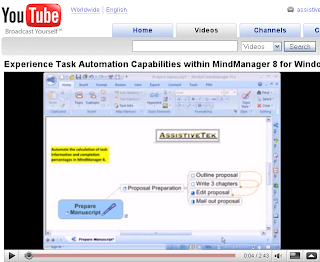 If you haven't taken a look at some of the new features in MindManager 8 then you should take a look at this video tutorial that I put together for the November Mindjet Connections Newsletter on the new Task Automation Capabilities.
If you haven't taken a look at some of the new features in MindManager 8 then you should take a look at this video tutorial that I put together for the November Mindjet Connections Newsletter on the new Task Automation Capabilities.
Thursday, November 27, 2008
Happy Thanksgiving!
Wednesday, November 26, 2008
Livescribe Pulse Smartpen adds Handwriting Recognition
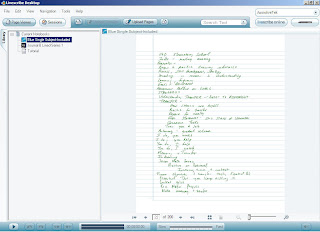 I have been using digital pen technology for a long time now but nothing has excited me more for the potential for this technology than the Livescribe Pulse Smartpen. I have been writing about my experiences using the Pulse Smartpen on my blog since its release and it continues to amaze me what is possible. I knew that it was only a matter of time before the Livescribe Pulse Smartpen would add handwriting recognition and I am happy to report that Livescribe announced yesterday the release of MyScript for Livescribe 1.0 from VisionObjects- which adds this significant feature. For those of you who would like to try MyScript for Livescribe 1.0 you will have to upgrade your Livescribe Desktop to Version 1.4 from the Livescribe website. Once you have made the upgrade you can download the trial version of MyScript for Livescribe 1.0, which will automatically install the MyScript icon into the tool bar of your Livescribe Desktop software. MyScript for Livescribe 1.0 is an independent application that once engaged from the Livescribe Desktop software will launch. I should note that the MyScript for Livescribe software application is $29.95 and can be purchased from the VisionObjects website.
I have been using digital pen technology for a long time now but nothing has excited me more for the potential for this technology than the Livescribe Pulse Smartpen. I have been writing about my experiences using the Pulse Smartpen on my blog since its release and it continues to amaze me what is possible. I knew that it was only a matter of time before the Livescribe Pulse Smartpen would add handwriting recognition and I am happy to report that Livescribe announced yesterday the release of MyScript for Livescribe 1.0 from VisionObjects- which adds this significant feature. For those of you who would like to try MyScript for Livescribe 1.0 you will have to upgrade your Livescribe Desktop to Version 1.4 from the Livescribe website. Once you have made the upgrade you can download the trial version of MyScript for Livescribe 1.0, which will automatically install the MyScript icon into the tool bar of your Livescribe Desktop software. MyScript for Livescribe 1.0 is an independent application that once engaged from the Livescribe Desktop software will launch. I should note that the MyScript for Livescribe software application is $29.95 and can be purchased from the VisionObjects website.So how does it work you say? I updated my Livescribe Desktop to version 1.4 and installed the4 trial version of MyScript for Livescribe 1.0 without a hitch. Once installed there now appeared a
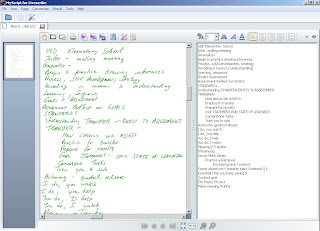 new icon on my Livescribe Desktop toolbar. I opened a page of some notes I had just recently taken at a conference and clicked on the MyScript icon which automatically launched the MyScript for Livescribe 1.0 application. Once launched you see a two page view of your handwritten notes on the left hand side of the page and by simply clicking on the conversion icon you text is recognized and appears on the right hand side of the page. You can go into the MyScript Preferences and select from three different handwriting modes, Hand Print, Capital Letters, and Natural Handwriting to help the recognition engine along. One more click on
new icon on my Livescribe Desktop toolbar. I opened a page of some notes I had just recently taken at a conference and clicked on the MyScript icon which automatically launched the MyScript for Livescribe 1.0 application. Once launched you see a two page view of your handwritten notes on the left hand side of the page and by simply clicking on the conversion icon you text is recognized and appears on the right hand side of the page. You can go into the MyScript Preferences and select from three different handwriting modes, Hand Print, Capital Letters, and Natural Handwriting to help the recognition engine along. One more click on 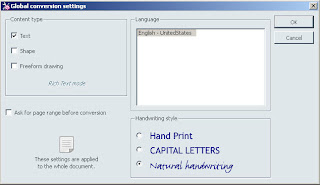 the Word icon, and your text transfers to a Word document-pretty neat! Once in Word the text is fully editable and ready to be reformatted. I should note that handwriting recognition has come a long way but it is not perfect. From my perusal of the Word document I would have to say that I was really impressed with the conversion process- with a little spell checking and some formatting my notes are now editable in Word. Having handwriting recognition is a significant feature and one that will allow students and teachers to use this technology to move their notes into Word with the ability to modify and make whatever accommodations that are needed. This is wonderful assistive technology tool and one that keeps getting better and better. This is a great gift for the holiday season.
the Word icon, and your text transfers to a Word document-pretty neat! Once in Word the text is fully editable and ready to be reformatted. I should note that handwriting recognition has come a long way but it is not perfect. From my perusal of the Word document I would have to say that I was really impressed with the conversion process- with a little spell checking and some formatting my notes are now editable in Word. Having handwriting recognition is a significant feature and one that will allow students and teachers to use this technology to move their notes into Word with the ability to modify and make whatever accommodations that are needed. This is wonderful assistive technology tool and one that keeps getting better and better. This is a great gift for the holiday season.
CoComment Co.mments Switch
I'm still not sure that there's a great overall answer to Blog Discussions Types. I discussed the specifics of Blogs, Community and Discussion Tracking - What's Really Needed a long time ago. Not sure that we've got an answer quite yet. It's still very messy to try to track all your activity across the network. Maybe there is no answer given how fluid everything is, but it still would be nice to have something better than what we have right now.
Tuesday, November 25, 2008
PollDaddy and MindManager 8
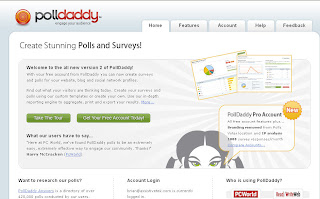 You probably know by now, that I like tinkering with new Web 2.0 services and decided to give PollDaddy a try. PollDaddy lets you create a free account and create polls and surveys free of charge. There are some limitations with the free account- but I decided to give it a try and see what happens. So if you can indulge me and fill out I the poll I created I would appreciate it.
You probably know by now, that I like tinkering with new Web 2.0 services and decided to give PollDaddy a try. PollDaddy lets you create a free account and create polls and surveys free of charge. There are some limitations with the free account- but I decided to give it a try and see what happens. So if you can indulge me and fill out I the poll I created I would appreciate it.On the heals of the release of MindManager 8 I thought it might be interesting to see what new features are most valuable to you and how you are using MindManager to accomplish your work and personal goals. I have also included some questions about your interest in training and what add-ins you are currently using with MindManager. So if you can take the time to complete it I will summarize the data and report back here with the results. Click here to go to the poll. Thanks- Brian
Conference Wiki Examples
For planning this year, we relied on Google Docs and Google Spreadsheets as the primary tools. This worked well with a small group and a small set of sessions. Likely the Wiki would be much better for something larger.
There have to be lots of examples like this out there. Can someone help out with pointers to a few?
Update - I was just pointed to Nonprofit Technology - Conference Wiki that pointed me to a couple of different posts that might be interesting such as: Collaborative Models for Capturing and Sharing Conference Notes at Nonprofit Gatherings. Of course, then I also checked eLearning Learning - Conference Wiki and found an old post of mine: Social Conference Tools - Expect Poor Result. These talk about slightly different issues, but still might be interesting.
Google Blog Search Problems
This completely defeats my purpose. I want a nice clean RSS feed of any posts that include links to my various sites.
I can't tell if this is something that is intentional, but it's been happening for a while.
I actually left Technorati for Google because Google appeared to be doing a better job. Time to evaluate my options?
Any suggestions on what to use for this?
Help Create Resources for Keynote?
I would really like to be able to point attendees, blog readers, and realistically a lot of other folks to a set of resources that would help them on these topics. But, I really don't have time to create what I want to create.
I'm not sure how we will create these (Google Docs, Wiki, Mindmap, etc.). I'm fairly flexible, but at the end of the day they need to be web pages that attendees of TechKnowledge and other folks can access. I definitely will post them to my blog. And chances are they will get quite a fair amount of page views.
I will certainly give credit to anyone who contributes in a meaningful way both in my blog and during the keynote (assuming this happens).
Here are the two resources that I'd like to see us work on ...
Work Literacy 2008
A set of resources for concept workers who are not early adopters to help them be aware of relatively newer methods and tools that they should consider adopting to help them in their day-to-day work. These would be organized around the following categories:
- Search
- Keep/Organize/Refind/Remind
- Leverage Expertise (Network)
- Collaborate
- Scan (Continuous Awareness/Learning)
A set of resources that would help workplace learning professionals get up to speed on:
- Introduction to Web 2.0 tools and their implications for Personal and Formal Learning
- What Learning 2.0 means to them both personally and professionally.
- Opportunities to apply Learning 2.0 in their workplace
- Introduction to Social Networking
- Introduction to LinkedIn
- Introduction to Facebook
- Introduction to Ning
- Using Social Networks for Personal Professional Development
- Using Social Networks with Learners
- Social Networking and Privacy
- Managing Your Networks and "Time Suck"
- LinkedIn Tips and Tricks
- Social Networking Wiki
Please drop me a comment or email me: akarrer @ techempower.com if you are willing to work a bit on this.
Monday, November 24, 2008
Evaluating the Performance of Knowledge Workers
Evaluating concept worker performance is an interesting challenge:
- No right answer - Most often there is no single right answer. Which authoring tool, LMS, etc. we should use in a particular situation - you can't possibly get it exactly right. You are trying always to arrive at a reasonably correct answer given all the other factors (amount of time you can spend finding an answer, etc.)
- Evaluator knowledge limit - In most cases, the person doing the performance evaluation knows less about the subject that the performer. So, they can't directly judge the answer, but may be able to sense when answers are possibly not correct.
- Process - They went through a reasonable process to arrive at their conclusions.
- Reasonable - Their conclusions are reasonable in your opinion (if you can formulate one).
- Compare - If you took what they did and compared it to what you would expect from other similar performers, would they have arrived at the same result.
What I've been saying in recent presentations is that going to Google and searching for information as your primary mechanism leaves you open to criticism. Instead, having a conversation with a peer can give you feedback on:
- Was my process appropriate?
- Is my answer reasonable?
- How does my answer compare?
There's a beauty in this!
But it does require better ability to reach into networks for help.
Saturday, November 22, 2008
TwitterBerry for BlackBerry Curve
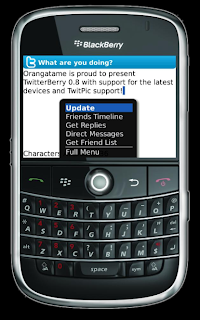 I have become a real fan of Twitter and am using it more and more to follow my colleagues and thought leaders in various fields. I have found it to be indispensable for following and tracking the latest trends in technology. Just recently I was able to follow the tweets for the DevLearn2008 Conference that I was unable to attend to keep up with the latest news from the conference. I'm sure you are finding interesting ways to use Twitter. Today I installed TwitterBerry on my BlackBerry Curve and now have full Twitter functionality from my smartphone. I tried it this evening with great success-now I have Twitter in the palm of my hands. You can Follow me on Twitter @assistivetek Hope to hear from you- so send me a tweet!
I have become a real fan of Twitter and am using it more and more to follow my colleagues and thought leaders in various fields. I have found it to be indispensable for following and tracking the latest trends in technology. Just recently I was able to follow the tweets for the DevLearn2008 Conference that I was unable to attend to keep up with the latest news from the conference. I'm sure you are finding interesting ways to use Twitter. Today I installed TwitterBerry on my BlackBerry Curve and now have full Twitter functionality from my smartphone. I tried it this evening with great success-now I have Twitter in the palm of my hands. You can Follow me on Twitter @assistivetek Hope to hear from you- so send me a tweet!
ASTD TechKnowledge
I'm doing two sessions including a keynote / general session - descriptions below.
If you are planning to go to the conference and read this, please drop me a comment because Get Together at Conferences - F2F Still Matters.
Better yet, go take a look at:
- Be an Insanely Great Professional Conference Attendee
- Better Questions for Learning Professionals
- Continuing Thoughts on Questions
- What Questions Should We be Asking?
- Session Hopping a Practical Guide
New Work Literacies and E-Learning 2.0
Thursday, 01/29/2009 8:00AM - 9:00AM
Over the past 20 years, there has been an explosion of information sources, greatly increased accessibility of experts and expertise around the world, and new tools emerging every day. These changes are continuously transforming the landscape for knowledge work. How are we doing at keeping up with these changes? The results are in, and most knowledge workers are struggling to adapt to new forms of work and learning. This situation represents the challenge of our age. As learning professionals, we have an opportunity to take a leading role. To do so, we have to look beyond formal learning solutions toward solutions that support self-directed learning.
In this keynote, Dr. Tony Karrer will look at the transformation of knowledge work into concept work and the implications for the roles and responsibilities of learning professionals. We will look over the shoulder of a modern knowledge worker using e-learning 2.0 methods to see examples of where and how tools such as social networks, social bookmarking, wikis, blogs, and RSS readers fit into day-to-day knowledge work and larger learning solutions. Tony will also discuss the big picture implications for learning organizations and how to get started as you begin to focus on this important opportunity.
Learning 2.0
Thursday, 01/29/2009 4:00PM - 5:30PM , Room Brasilia 2/3
As described in the keynote on Work Literacy, there is an incredible revolution happening in knowledge work and learning. A big part of this revolution is a move towards Learning 2.0 - a shift in the way that knowledge workers work and learn. Personal, collaborative, and informal learning methods are emerging that leverage tools such as blogs, wikis, social bookmarking, and RSS readers. This session will explore these Learning 2.0 tools and their implications on personal and formal learning. We will look at adoption trends and examples of eLearning 2.0. We will discuss common barriers and ways to work around some of these barriers. Come to this session to learn about these tools and methods and immediate opportunities to apply them in your organization.
Export as Mindjet Player Tip- Linking Documents
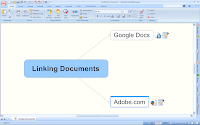 I for one am having a great deal of fun experimenting with the new Export as Mindjet Player feature that can be found in MindManager 8. I have begun to export all of my MindManager maps to this format so that I can share them with my students on their Blackboard accounts. I have all of my lectures mapped out with links to web sites which I use for every class. Back in the days of MindManager 7, I would export my MindManager maps to PDF and post them to Blackboard, but the links were no longer live which always presented a problem. Now with the new Export as Mindjet Player I can put the maps on Blackboard and ask my students to open it and they can quickly jump from web site to web site as we talk about different topics. This has been a tremendous time saver for me. If you have taught using the internet- it is cumbersome when you have to stop and write the URL on the board and invariably some of your students are going to misspell the link and have trouble getting to where you want them to be.
I for one am having a great deal of fun experimenting with the new Export as Mindjet Player feature that can be found in MindManager 8. I have begun to export all of my MindManager maps to this format so that I can share them with my students on their Blackboard accounts. I have all of my lectures mapped out with links to web sites which I use for every class. Back in the days of MindManager 7, I would export my MindManager maps to PDF and post them to Blackboard, but the links were no longer live which always presented a problem. Now with the new Export as Mindjet Player I can put the maps on Blackboard and ask my students to open it and they can quickly jump from web site to web site as we talk about different topics. This has been a tremendous time saver for me. If you have taught using the internet- it is cumbersome when you have to stop and write the URL on the board and invariably some of your students are going to misspell the link and have trouble getting to where you want them to be.One of the limitation of the first release of Export as Mindjet Player is that you can not embed your attachments. After thinking about this for a little while, I realized that while you can't attach documents that are stored on your computer, however, what about your documents that are stored on Google Docs or Acrobat.com? Instead of attaching documents to my MindManager
 maps I could simply hyperlink them to my documents. Yes- this does limit the number of attachments but it gets the job done. It was certainly worth trying and in fact my solution does work. Here is how to do it. In Google Docs open up your document that you want to be able to share and click the Share tab and select Publish as Web page. This will automatically create a unique URL that you can share with other to access your Google Docs. Now just create a link in Mindjet MindManager with that unique URL and you are ready to go. Remember you can also upload your Microsoft Word documents and bring them into Google Docs and be able to accomplish the same thing.
maps I could simply hyperlink them to my documents. Yes- this does limit the number of attachments but it gets the job done. It was certainly worth trying and in fact my solution does work. Here is how to do it. In Google Docs open up your document that you want to be able to share and click the Share tab and select Publish as Web page. This will automatically create a unique URL that you can share with other to access your Google Docs. Now just create a link in Mindjet MindManager with that unique URL and you are ready to go. Remember you can also upload your Microsoft Word documents and bring them into Google Docs and be able to accomplish the same thing.I have been using Acrobat.com for a lot of the consulting work that I am doing and it is just as
 easy to link your documents (Word, Excel, PDF's, etc) in your Acrobat.com account to your MindManager 8 maps and then Export as Mindjet Player and retain the attachments. In fact
easy to link your documents (Word, Excel, PDF's, etc) in your Acrobat.com account to your MindManager 8 maps and then Export as Mindjet Player and retain the attachments. In fact 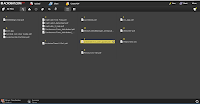 you will find the process a lot easier. Once you go to the MyFiles directory- simply select the file you want to link and make sure that you have selected Open Access which will let you share your files with others. Now simply click on the Copy URL button. Once you are back in MindManager 8 select the topic you want to link it to and bring up the Add Hyperlink and paste the link in. Now when you Export as Mindjet Player you will be able to access your documents from anywhere when you are connected to the internet.
you will find the process a lot easier. Once you go to the MyFiles directory- simply select the file you want to link and make sure that you have selected Open Access which will let you share your files with others. Now simply click on the Copy URL button. Once you are back in MindManager 8 select the topic you want to link it to and bring up the Add Hyperlink and paste the link in. Now when you Export as Mindjet Player you will be able to access your documents from anywhere when you are connected to the internet.While I hope that at some point in time we will be able to attach documents that can be embedded into the Mindjet Player for now this is a workaround that should serve us well for maps that we would like to share with others. Let me know what you think of this strategy. You can preview the file that I created by clicking here.
Friday, November 21, 2008
No More Little Sandwiches
I created my post and immediately felt remorse when Mark Oehlert immediately (via Twitter) asked, "Did you contact them?" That would have been the smarter thing to do in hindsight, but this has been a learning week for me (euphamism for making lots of mistakes).
PBWiki's Founder and Chairman, David Weekly, explained -
Here's what happened1) You were comp'ed a premium version of the service a year ago as a way of saying thanks for past feedback.
2) This premium comp expired.He was too nice to say that likely I received a notice about that which I may have ignored.
3) Our product places the sandwich in the corner of third-party-hosted images for free wikis as a general way of gently deterring people from using us as free image hosting. There were quite a few wikis that were using us to host very large images on MySpace a year or so ago.Yeah, I don't look particularly good in this story. Sorry, David and the PBWiki team. I felt blindsided, but the reality is that likely I got a notice telling me that my premium account was expiring. I assumed that didn't mean any changes as I pretty much only use the basics on PBWiki. So, I ignored it. Whoops.4) To fix this problem, we've reupped your wiki to the paid version.
David also said something along the lines of - "owing to your influence" - "appreciate if you'd alert us of problems" - this is a bit of a mind shift for me. I don't think of myself as "influential" - I'm one of a lot of signals out there.
I've been a PBWiki fan and saying what I said was more of a factor of surprise. At the same time, this is the second time in a couple of months that someone has told me something similar (that I said something not flattering and it may/did have a negative impact). So, I think I need to factor that in a bit as I post. I don't want to gate myself too much, but I definitely should have handle this differently. Again, apologies David and team.
The other thing he said was "I think you'll find our support is speedy and helpful and you'll be able to quickly resolve your issues." In fact, several people had already said that to me independent of David. Certainly they were very responsive in this case. And I don't think it was because I'm "influential." My sense is that they are responsive.
So, bottom line - I learned something in this process. Little sandwiches are gone for me, but will be there if you use PBWiki for image hosting (display on external sites). And, I'm going to stick with PBWiki.
What's that old axiom about customers who have had a difficulty that gets resolved are more attached than those that never have had any issue?
Oh, and I'll try to pay attention to messages a bit better. Ah, who am I kidding, if it didn't say that little sandwiches are about to appear on top of all of your images in the subject line, I probably still wouldn't catch that the expiration of premium would do that.
Now, maybe I need to go back through my posts and figure out who else I may have said bad things about. For example, Twitter. And at the start of my story when I mentioned that Mark suggested to contact them. That was through Twitter. Hmmm ...
Learning Communities List
The discussion today suggested that it would be nice if there were a way to transfer the connections being made during the conference out to other networks or learning communities. I would highly encourage everyone who I connected with during the conference to connect to me on LinkedIn. I've connected to a couple of fellow bloggers.
But the issue of other learning communities was raised. This relates to the discussion of Getting Help. In that post, I suggested some places (learning communities or networks) when I need help.
I've not seen a good list of learning communities to go to in an on-going basis. So, I'm trying to form a list of on-going learning communities that learning professionals should know about. I'd prefer to add online communities that have fairly substantial membership, with active discussions and/or good ways to reach out to the members to get help.
Please add comments below to help me flesh out this list.
- TrDev - Large, Moderated - Training and Development Discussion Group begun in October 2000. Discussions deal with a wide variety of topics. Assessment, benchmarking, competencies, content development, course development, e-learning, EPSS (electronic performance support systems), evaluation, instructional systems design (ISD), job aids, knowledge management, learning characteristics, learning outcomes, learning styles, needs assessment, objectives, performance improvement, return on investment (ROI), strategic analysis, task analysis, tools for training and learning, train-the-trainer, training and development.
- (E-)learning network - Fairly active LinkedIn group/network for professionals working in the (E-)learning industry and informal learning industry.
- ASTD National - ASTD's LinkedIn group. Lots of members and discussion.
- Courseware Development - Smaller LinkedIn group started by Ted Kopp interested in courseware design and development. Some discussion.
- eLearn - Fairly large LinkedIn group for sharing ideas, concepts, and technology for eLearning. Discussion varies.
- Learning, Education and Training Professionals Group - a large LinkedIn group for training professionals, including project managers, instructional designers, developers, learning environment engineers, learning officers and classroom trainers. Fairly active.
- The eLearning Guild Linked In Group - LinkedIn group for members of The eLearning Guild. Fair amount of discussion on design, development, and management of eLearning.
- DEOS-L - The Distance Education Online Symposium. Listserv for professionals and students in the field of distance education and provide a forum for discussion of all aspects of distance education.
- ASTD Discussion Forums - Fairly active discussion forums on wide variety of topics such as e-Learning, consulting, OD & Leadership, Performance Improvement.
- LearningTown! - Large, active Ning community hosted by Elliot Masie with monthly questions that spark discussions. Some subgroups emerging.
- Chief Learning Officer Network - Fairly active Ning community that has broad range of topics.
- Classroom 2.0 - Very active Ning community looking at web 2.0 in education including tools, curriculum, integration, design.
- Content Management Professionals collaborative community with 7731 learning professional members who practice advancing the field of content management
Thursday, November 20, 2008
Real-Time Collaborative Editing
- Easy to use
- Easy to distribute (give everyone a URL)
- No download required
- Support chat and document editing
Well I think I just found it... and it's called EtherPad. It's pretty ugly, but it does exactly what I asked for. People come in easily and just put their names in there.

Couple of notes:
- I've only used this for a small test. If you use it for anything bigger, please let me know.
- I think that a key ingredient is setting things up ahead of time so people will know what to do. Random notes may not be a great effect. It needs to be used with a purpose.
- Still it may be more interesting to get a collective set of notes and chat, especially with some structure. (More on this below.)
Google Spreadsheet handles real-time editing (using the cells as protectors) much better.
Also, I still don't understand why Google Docs don't have notifications of changes like Google Spreadsheet. That has to be one of the worst decisions they made on the product. But now I'm on a tangent.
Google Docs are much harder to share with other people. Trying to share it at a conference would be a lot harder. And people need to have a Google account.
Google Docs doesn't highlight who is doing what.
In short, Google Docs isn't really made for real-time editing.
While I'm on the subject of real-time collaborative editing, I just had a fantastic experience via Robin Good where he used MindMeister to allow participants to collectively edit a Mind Map during a session at the Learning Trends.

This mind map started with just the first level nodes that represented the categories. He asked people to add to those and people started typing in all sorts of things. It was very interesting to see.
I still think the most powerful work example for this has been real-time collaborative editing of Google Spreadsheets that contain project status reports. You get the team online at the same time and you can all talk and edit to get the status updates, next steps assigned in a very short period of time. It's really a fantastic effect.
It's exciting to see real-time collaboration (something I worked on 15 years ago while I was a Ph.D. student) finally taking off in the real-world.
The November Mindjet Connections Newsletter is Out
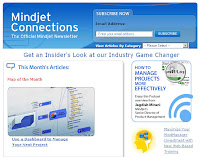 Just wanted to let you know that the November Mindjet Connections newsletter is out and it is chock full of some great articles on how to maximize your investment in MindManager. Find out new ways to save time and expand the ways you can utilize MindManager in the work that you do.
Just wanted to let you know that the November Mindjet Connections newsletter is out and it is chock full of some great articles on how to maximize your investment in MindManager. Find out new ways to save time and expand the ways you can utilize MindManager in the work that you do.
What is Rapid eLearning?_12
What is Rapid eLearning?
Note: this is being done to try fix issues with broken links to old posts.
Wednesday, November 19, 2008
PBWiki Image Overlay - Yuck
I just took a look at my blog and wow, all of my images that I've been keeping on PBWiki for use on my personal Wiki and for use on my blog have randomly started having an image overlayed on top of my images with their logo. You can see two examples below that I've saved from PBWiki and then uploaded to blogger.


I don't think I received any kind of warning about this. That's pretty bad. So, I go from being a raving fan telling people about them during presentations (literally yesterday was one example) to a person who now can't recommend them because who knows what they will do in the future.
Now I have to go out and figure out who I'll use instead.
Tuesday, November 18, 2008
eLearning Learning Update
Several of my favorite bloggers have been added into the mix. I'm also listing what they show as their top tools in the widget for some of them - which I find interesting. It gives me a sense of the tools they talk about.
Cammy Bean - Learning Visions
- Technorati (3)
- Twitter (3)
- Second Life (2)
- Facebook (1)
- RSS (1)
- Slideshare (1)
Mel Aclaro - Business Casual Blog
- Twitter (41)
- LinkedIn (32)
- RSS (18)
- Social Network (15)
- Facebook (6)
Ken Allan - Blogger in Middle Earth
Joe Deegan - Blender Training Solutions
David Fair - Learning Journeys
Lars Hyland - Lars is Learning
Jay Cross - Internet Time
Eric Tremblay - eLearning Acupuncture
We have several upcoming planned improvements to the site that will be rolling out over the next few weeks and months. I'm definitely interested in suggestions.
I will likely also be asking for help with some curatorial / moderation kinds of activities in the future. If you are interested in participating that way, please let me know via email: akarrer @ techempower . com.
Get Help - Spam?
- How to reach out and find expertise
- How to use Social Media to Find Answers to Questions
- How to Learn through Conversation
Karl Kapp's response sparked some things for me. First, he tells us that there's not one right place to get help. I think that's part of the question. We know of several and may have different levels of experience and we go through some process when we decide. Then he makes a great point:
With Web 2.0 and social networks, the cost of asking a question and seeking advice from several different channels simultaneously is so minimal that it no longer matters whether or not you know the right place to ask the question. Ask it in multiple places because you never know who might have the answer and the overall cost is negligible.So, the cost graph with Web 2.0 and all the tools make it such that you can push your question into many areas. Maybe spending time choosing is not the way to go at all. Just get good at quickly pushing the question out to all the networks you have. He has an example of where he sends it to five places simultaneously.
What I wonder about sending out to all of these places at the same time is that likely the same people will see the same question going by. What is their perception of multiple questions by the same person? Do they think of it as spam?
I'm curious what people think on this.
Monday, November 17, 2008
Manager Training Online Courses
I'm looking for vendors who supply off-the-shelf training for basic manager skills such as, time management and delegation. Thus far I've looked at Element K, SkillSoft, Vital Learning, Ninth House, and Achieve Global. What I like about these providers is the scope of what they offer -- many courses to choose from. Are there other providers you'd recommend I look at?Those vendors are certainly at the top of my list and I'm not sure I have other suggestions. Any other providers that folks would recommend they look at? And why?
Online Learning Course Design
Here are some thoughts on the course and the implications for design of similar kinds of online learning courses.
Social Network as Course Platform
Like social networks generally, Ning, unfortunately feels a bit scattered. There are lots of places to wander around and see things. It's not always easy to feel like you've seen "everything" or even the important stuff. Students likely will feel "Am I done?" "Is this where I should be looking?" At the same time, I think that it worked extremely well to allow discussion with fellow professionals to be the basis for the course. And you can't control discussion, it will go where it goes based on interests. To me this is often the best kind of learning. However, it does feel quite different for participants.
I believe that many learning experiences designed to reside in a social network will inherently feel more scattered. In discussing Facebook Learning, certainly if you look at the types of things involved, it will be scattered.
But - if you consider that part of the goal of the course was to have an experience of learning in this way, I actually think this was exactly right. Participants certainly experienced what it was like. And, if I were designing something for new hires or another group of learners, I think it gave a pretty good idea of what the experience would be like.
Spectator / Joiner / Creator Levels of Participation
One of the best decisions we made early in the design of the course was to define different levels of participation in the course. Here's how we defined it:
Each week we will share new activities that will allow you to explore each of these tools. We recognize that there will be differences in interest, experience and time available for exploration, so these activities will be designed to give you meaningful experiences at different levels:By doing this, we allowed people to particpate in different ways. A person who wanted to more actively explore something could do so and add value to the rest of the group. They would more actively engage with other highly active participants. But people who wanted to be a spectator were given permission to participate in other ways. And people who only wanted to comment or discuss were allowed to do that. This works out extremely well, but requires a fairly large audience to be successful.
* The Spectator--These will be exercises or activities that should take approximately 15 minutes to complete. The Spectator level is for people who want just a quick exploration of the tools and minimal interaction.
* The Joiner/Collector--For those who want to delve more deeply into a particular Web 2.0 tool, the Joiner/Collector level will consist of activities that take approximately 30 minutes to complete.
* The Creator--These activities are for people who want to really spend some time exploring and trying out a particular tool or set of tools. The activities will take approximately 75 minutes to complete and will allow you to immerse yourself in the Web 2. 0 experience.
Length / Duration of Course
We saw a drop-off in participation, especially active participation, as the weeks progressed. We still had lots of visitors, but the number of posts decreased. To me, this suggests that it would be better to do this over a relatively shorter period of time - possibly two weeks. But that's hard as well. There's a certain amount of learning curve to get into and going on the social platform. The amount of content would need to be small. I'm still not sure we have the right balance. I wonder if an on-going course that would have one week a month might not be an interesting model. One of the advantages of doing things online is that we could (and should) experiment with other schedules.
Facilitator Participation
Harold, Michele and I all suffered from trying to fit in facilitation among other work. Sometimes we were more active. Other times less so. It made it hard to ensure that each of us were helping to keeping things interesting, moving, etc. For me, it was sheer volume of discussion, comments, etc. that would take time to review, comment on, etc. that made it difficult. I also found it hard to get on each day and spend that kind of time. Michele and Harold did a much better job of it than I did.
To be more active facilitators would have taken much more time. On the other hand, it had a somewhat good effect to allow conversation to be driven by the audience.
Overall
When I took at look at Feedback from Participants, I was struck that through the opportunity there were quite a few people who received quite a bit of value from the course. I really think that it achieved its basic purpose. Trying to provide exposure to these tools and their implications for personal and formal learning.
Sunday, November 16, 2008
Find Speaker for Local ASTD Chapter
But in the cases where that's not going to work out, I would really like to help the person find a speaker who is local and who can speak to the issues around eLearning 2.0, Work Literacy, etc. This is similar to the issue being discussed as part of this month's Big Question - Network Feedback and in Getting Help.
So, I'm hoping that folks can recommend what I should do with a request such as a request I just received (and they've allowed me to post it publicly) for help:
I need a speaker in the Birmingham, Alabama area for a local ASTD on eLearning 2.0 or Work Literacy.What would you do if you were me? Where would it make sense to post? How would your answer change if you got one request like this per week vs. one per quarter?
Oh, and if you know someone who might be a good fit, please let me know.
Saturday, November 15, 2008
Camtasia Studio 6- Impressive!
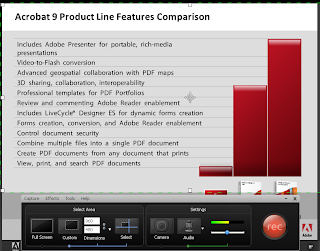 home with the latest version- which is a good thing. I am always concerned when software companies make drastic changes to the interface when they release new versions of the software. Having stated this up front, TechSmith has spent considerable time and taken user input in designing this latest version. I for one feel that the workflow is much smoother and some of the subtle changes in the interface make the whole experience of using Camtasia Studio 6 much more enjoyable. From the first time you record a session you will notice a whole new recording interface which is much more intuitive and allows you to set up your recording features without the need to jump through a whole lot of screens.
home with the latest version- which is a good thing. I am always concerned when software companies make drastic changes to the interface when they release new versions of the software. Having stated this up front, TechSmith has spent considerable time and taken user input in designing this latest version. I for one feel that the workflow is much smoother and some of the subtle changes in the interface make the whole experience of using Camtasia Studio 6 much more enjoyable. From the first time you record a session you will notice a whole new recording interface which is much more intuitive and allows you to set up your recording features without the need to jump through a whole lot of screens.Everything is right there in front of you as you see in the screenshot. You can now easily adjust your audio, select your screen size, as well as your webcam from the
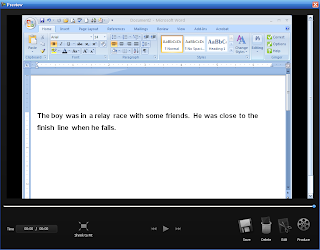 Record pane.
Record pane.When you are ready to record just click in the big Record button and you are ready to record high quality video and audio form your computer. You will be happy to learn that you can now use Camtasia Studio to record in High Definition (HD- H.264) should you need to. After recording your video you can quickly preview your video in the newly designed Preview screen. The interface is very clean and neat and it is very clear how to save, edit, delete or produce your video. By clicking on the edit button you are taken to the very familiar Camtasia Studio screen to edit and produce your work. While not much has changed with regard to the interface there is lots of changes under the hood
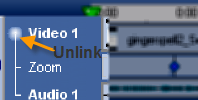 which will benefit all of us who work with this wonderful tool. This is the first version of Camtasia Studio that lets you decouple the video and audio which will make it easier to make edits and re-record the audio for retakes. TechSmith has now added a number of Hotkeys which will allow us to quickly add captions, callouts, zoom, and markers to the timeline. Just today I created a video and wanted to add a zoom in- and by simply pressing the letter z, I was able to bring up the Pan and Zoom dialog box and insert the zoom. This is certainly going to reduce the amount of time it takes to create and produce my videos. Like I said before, a lot of work has gone on under the hood which we will greatly benefit from. When it comes time to produce our videos TechSmith has really listened to our call and with the Production Wizard we can now output our videos to some of the most popular formats without the need to worry about the settings. We can now produce videos in High Definition (HD), SWF, as well as produce it for YouTube, Screencast and for the iPhone by going through the Production Wizard. In every case you will get perfect video and audio for that platform which is extremely important from my perspective- no need to guess. If you have a Screencast account you will appreciate just how easy it is to store and post your videos to your blog or web. The integration is seamless and within minutes you can have your video on your web or blog.
which will benefit all of us who work with this wonderful tool. This is the first version of Camtasia Studio that lets you decouple the video and audio which will make it easier to make edits and re-record the audio for retakes. TechSmith has now added a number of Hotkeys which will allow us to quickly add captions, callouts, zoom, and markers to the timeline. Just today I created a video and wanted to add a zoom in- and by simply pressing the letter z, I was able to bring up the Pan and Zoom dialog box and insert the zoom. This is certainly going to reduce the amount of time it takes to create and produce my videos. Like I said before, a lot of work has gone on under the hood which we will greatly benefit from. When it comes time to produce our videos TechSmith has really listened to our call and with the Production Wizard we can now output our videos to some of the most popular formats without the need to worry about the settings. We can now produce videos in High Definition (HD), SWF, as well as produce it for YouTube, Screencast and for the iPhone by going through the Production Wizard. In every case you will get perfect video and audio for that platform which is extremely important from my perspective- no need to guess. If you have a Screencast account you will appreciate just how easy it is to store and post your videos to your blog or web. The integration is seamless and within minutes you can have your video on your web or blog.TechSmith has done a great job of listening to its users and making it even easier to produce high quality screencasts. It is the subtle changes and the work under the hood that will change your
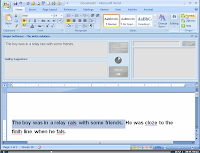 workflow and make you more productive using Camtasia Studio 6. The videos that I have recently recorded with Camtasia Studio 6 are very sharp with excellent audio fidelity. If you are on the fence about the upgrade to Camtasia Studio 6 take the plunge and see all of the benefits that you will derive with this very substantial upgrade. You can also download a 30 day trial of Camtasia Studio 6 form the TechSmith web site.
workflow and make you more productive using Camtasia Studio 6. The videos that I have recently recorded with Camtasia Studio 6 are very sharp with excellent audio fidelity. If you are on the fence about the upgrade to Camtasia Studio 6 take the plunge and see all of the benefits that you will derive with this very substantial upgrade. You can also download a 30 day trial of Camtasia Studio 6 form the TechSmith web site.
Learning Trends Starts Monday
You can find the Schedule of Sessions. Be careful that all times are Pacific Time. And Ning's time converter does not work.
There will be some interesting discussions going on in the Ning group based on the presentations.
To get into the live sessions go here:
Live Session
Friday, November 14, 2008
Adding Mindjet Player PDF's to a Acrobat Portfolio
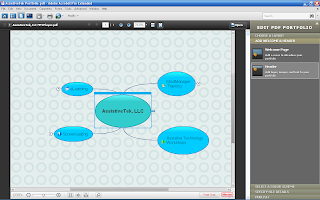 This has been a very exciting week as I explore some of the new features in Mindjet MindManager 8. As I have shared with you, one of the most exciting features from my perspective is the Export to Mindjet Player, which allows you to create shareable maps with anyone who has Adobe Acrobat Reader 9, on their computer. This feature allows you to open and close topics and subtopics and maintains live links to the web. Being one who likes to experiment with software, I wondered what would happen if I placed a Mindjet Player PDF into one of my Adobe Acrobat Portfolio's that I have created. At the present time the Mindjet Player does not support attachments so one of the ways around this if you own a copy of Adobe Acrobat 9 is to create a Portfolio and add the files you would like to the portfolio. Inserting the Mindjet Player file into my portfolio was very easy and worked right out of the box. Double clicking on the Mindjet Player opened the map and from there I was ready to go. Now I can have my MindManager 8 maps displayed and add whatever additional files I need right within the portfolio. You will find as I have, that creating Acrobat portfolios is a great way to package files for training and consulting.
This has been a very exciting week as I explore some of the new features in Mindjet MindManager 8. As I have shared with you, one of the most exciting features from my perspective is the Export to Mindjet Player, which allows you to create shareable maps with anyone who has Adobe Acrobat Reader 9, on their computer. This feature allows you to open and close topics and subtopics and maintains live links to the web. Being one who likes to experiment with software, I wondered what would happen if I placed a Mindjet Player PDF into one of my Adobe Acrobat Portfolio's that I have created. At the present time the Mindjet Player does not support attachments so one of the ways around this if you own a copy of Adobe Acrobat 9 is to create a Portfolio and add the files you would like to the portfolio. Inserting the Mindjet Player file into my portfolio was very easy and worked right out of the box. Double clicking on the Mindjet Player opened the map and from there I was ready to go. Now I can have my MindManager 8 maps displayed and add whatever additional files I need right within the portfolio. You will find as I have, that creating Acrobat portfolios is a great way to package files for training and consulting.You may have noticed that I have placed a new widget on my blog recently to have you sign for free premium assets and information. This will allow me to target my readership and provide you with timely information which may include video's, newsletter, and or articles. For those of you that sign up now I will email you a link to Portfolio so that you can see just how easy it is to package your maps and attachments. So if you have a moment, please subscribe for the free services at the top of the blog by entering your name and email address- thanks Brian
Thursday, November 13, 2008
eNapkin
- keynote at DevLearn. You can find something similar here.
What problems can we solve with pictures? All of them. We all know how to do this.
Three quarters of our brain is dedicated to visual processing.
After you hit age six or seven, in education we stop emphasizing visual thinking.
The act of creating the picture forces us to think in new ways.
Whoever best describes the problem is the one most likely to solve it. (Much like asking better questions.) Subtext: whoever draws the best picture gets the funding. Southwest airlines started on the back of a napkin in a bar in San Antonio. They print all their cities on their napkins. Presidential Doodles: Two Centuries of Scribbles, Scratches, Squiggles, and Scrawls from the Oval Office squiggles & scrawls from the Oval Office
Arthur Laffer - take place in a bar - drew the famous Laffer curve. Drew it originally for Rumsfeld and Cheney. Great story.
25% of the people in any meeting - black pen people - can't wait to get to the whiteboard and start drawing.
50% of the people say - "I can't draw", but can go and highlight. Good at highlighting important parts.
25% sitting back - red pen person - say - "Mapping out problem at superficial level." Too much detail.
Way to get red pen person to the board is to get them so upset that they feel they need to get to the board.
Why do we use PowerPoint to communicate? Just a tool. What PowerPoint allows to do, enables us to become lazy to turn off and fill in the squares in.
How to create an eNapkin? Can run PowerPoint in Adobe Connect, WebEx or other virtual meeting software. PowerPoint - launch it and run the best drawing tool - on screen drawing application within PowerPoint. Lower left corner icons. Touch sensitive drawing tool. Can see them at same time. Really crazy part is that anyone can participate.
I will have to try out the eNapkin.
By creating something on the paper, you get over the hurdle of where to start. He suggests a pattern with "Me" and "My Problem" ...
Bill Gates quote - The barrier to change is complexity.
Shows picture of MS Word with all the tool bars open.
Drawing pictures of interface ignored details and that actually got around common objections.
The more human your picture, the more human your response. The mind likes to look at things that match the way we see. The six ways we see:
- Who/What - identify the objects in the world
- How many - identified how many of them there are - more than three - more than 9 - thus it's a lot.
- Where - only tells us where things are - in reference to where you are. Only combined later in the brain.
- When - represent passage of time by seeing location of object in time
- How - looks for patterns
- Why - make sense of the patterns
- Who/What - Portrait
- How much - Chart / Dots
- Where - Map
- When - Timeline
- How - Flow chart
- Why - Mutlivariable plot (diagram with multidimensional data)
Wong-Baker faces chart Pain Rating Scale. Tufte - information visualization. Venn diagram shows conceptual spatial relation between objects. Hard to get something drawn in a circle.
Any problem is like a big layer cake. There are more flavors inside than anybody expects. Start with a general drawing and then drill down.
Wednesday, November 12, 2008
Mindjet Player Screencast
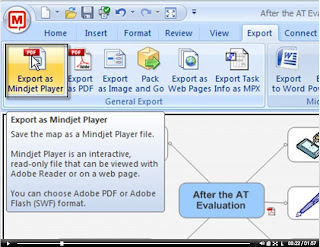 I am really jazzed up about the Export to Mindjet Player feature found in MindManager 8 because it opens up all kinds of possibilities for teaching and training. In the this screencast I demonstrate just how easy it is to share your maps using MindManager 8. You can click on the screenshot below to launch the screencast. Just a note once the Title screen appears you will need to click on the Play button to continue to view the screencast. Enjoy!
I am really jazzed up about the Export to Mindjet Player feature found in MindManager 8 because it opens up all kinds of possibilities for teaching and training. In the this screencast I demonstrate just how easy it is to share your maps using MindManager 8. You can click on the screenshot below to launch the screencast. Just a note once the Title screen appears you will need to click on the Play button to continue to view the screencast. Enjoy!
eLearning Research
- Will Thalheimer, Work Learning Research
- Kevin Oakes, I4CP
- Claire Schooley, Forrester
- Chris Howard, Bersin
- Kevin Martin, Aberdeen
Talent management being discussed in the board room. Performance management. Learning and performance management converging finally. Linking development plans, career paths, learning opportunities. Leap to 2.0 before they get the foundation right.
Good, Chris, called him on this. Learning 2.0 is so different. 2.0 is chaotic. Talent management is structured.
Statistics from ASTD research -
- 86% - web 2.0 technologies likely to use more in learning function than they do today
- 41% - using technology for informal learning at high or very high extent
Learning 2.0
- Trust is barrier
- Culture is number one barrier - knowledge sharing is problem
- Reluctance among potential mentors to teach each other
- Time is problem
What percentage should they invest in Learning 2.0 - answers ranged from 20 to 50%?
Economy
Do we have to do anything different?
- Shift priorities to align better.
- Use cost lowering technologies (video conferencing, web conferencing) to save money
- Look at criticality of retaining workers
- Improve performance of existing workforce
- Should be good for L&D to be more accountable
Focus on how you can impact sales and cost reduction activities. That's what people care about during tough times.
Talent Management
Where does learning fit in? Is training organization taking a back seat?
Strategic effort - learning is part of it, but not leading it. Broader focus. Especially when you talk "Integrated Talent Management."
Kevin mentions how Learning Management System companies have move towards Talent Management. See Rise and Fall of LMS.
Why are you getting into talent management?
- Compete in marketplace
- Retain
- Need to innovate
Informal quarterly reviews were differentiator between best in class and those not.
Measurement
Must be done the way the business does itself. Revenue. Profitability.
Not a top priority. Talk about it. Don't actually do as much as they should.
Recognize they are not doing as a good a job as they could, but generally roughly okay.
Best-of-class (top 20%) - want to have metrics. Which means they don't today.
Josh Bersin's book suggested as resource for what impact training has on organizational performance - The Training Measurement Book: Best Practices, Proven Methodologies, and Practical Approaches
Best in class - training organization design. Hub and spoke is a good approach.
Question from audience: Can learners effectively handle control of their own learning? What does research show?
Some debate, but no research on this yet. Somewhat goes to the fact that this would be hard to measure for most kinds of organizations.
Organizations need to think of Learning 2.0 as a learning style thing.
New Literacies
He uses the same quote I often use from William Gibson -
The future is already here, it's just not evenly distributed.Pattern recognition is key. What do these companies have in common:
- eBay
- Yahoo
- Amazon
- MapQuest
- Craigslist
- Wikipedia
- YouTube
Dell Ideastorm, Starbucks, Best Buy, SAP (Harmony), YattIt, BeingGirl (P&G) mentioned as examples. Allow people to share ideas. Social media in action.
At DevLearn - tend to equate Web 2.0 with Wiki, Blog, Social Bookmarking, Social Networking, etc. - instead it's really systems that harness network effects. The lock in is data.
Eras - Hardware (IBM), Software (Microsoft), Network/Data (Google). Data is the Intel inside of next generation. He's explaining PageRank.
Wesabe - contributing credit card data. Allows us to see spending at particular stores, repeat at stores. Wow, very cool data. Wonder how we could get access to that?
Mentions Google putting testing over the toilet.
What do you need to teach people? Not about the tools. It's about how to use them. How to leverage the data? Core competency of information age - leveraging collective intelligence.
Get away from old model of data. Hadoop. Computer Science shifted to teaching Hadoop to freshman from teaching SQL. Deals with messy data better.
Statistics. Design. "Big part of the new literacies."
These new literacies are not unlike talking about visual thinking as a literacy, new kinds of synthesis. The level of these "literacies" is interesting to me. Much more challenging to develop these literacies.
Suggestion - study the people who don't need your help. Go find the people who are on the leading edge and study them. The "Alpha Geeks."
Turn the Alpha Geeks into the mentors. They would pair Alpha Geeks with good writers.
Provide self-starters with access to the best resources. Online reference tool - Safari.
Show, then do, with reinforcement from frequent small successes. Get people engaged with the process.
Watch someone doing something right can improve your own performance.
Read in reviews - people talk about themselves. Very cool concept from Kathy Sierra. She is awesome at those kind of ideas.
Importance of hands-on. Magazine - "Make" about playing with technology.
Cites Wikipedia the missing manual. Literally just bookmarked How Wikipedia Works this morning.
People are telling us about these technologies, not telling us how to change. Create peer learning opportunities.
Study success stories.
"Stop fondling the hammer and focus on the house." - It's not about technology. It's about what you are trying to accomplish.
I'm not sure that Tim connected the high level concepts with what each person needs to do. I'll try to do it at 1:30 at my presentation. :)
Tuesday, November 11, 2008
Embedding MindManager 8 SWF Files
One of the most important features from my perspective that is new to MindManager 8 is the ability to Export to Mindjet Player in a PDF or Flash File (SWF) format. Now I'm able to share my MindManager maps with just about anyone who has access to Flash or Adobe Acrobat Reader- which are found on nearly 98% of all computers. In this post I am going to embed a MindManager 8 maps which has been exported as a SWF file. You will see below the results of me embedding the map. You have complete control over opening and closing the topics and you can click on the links to take you out to the web sites. This is going to be a tremendous feature for me when teaching my graduate course. I will now be able to post my visual maps as a Mindjet Player PDF file and post it to BlackBoard for all my students to access. What is really great is that the links and Notes are preserved. This alone is worth the price of an upgrade.
Per Question Reports
Our school district uses Blackboard. We have recently been exploring putting more coursework online and have experimented with the Articulate line of products. Blackboard has done well for us although I am not pleased with their support of the SCORM standards.This brings up a bunch of initial thoughts. First, having worked on custom LMS, LCMS, Authoring projects and being pretty deeply familiar with SCORM, it's easy to blame the LMS for poor reporting on per-question reporting, but its very hard for an LMS to create generic reports that work well across all the variations that you run into. So, if the source of the statement "I'm not happy with their support for SCORM" is only the issues of reporting, that's a bit unfair.
I would like to be able to export SCORM test results by user/by question but all Blackboard seems to support is general pass/fail records. Now I can drill down to the individual results via the Bb gradebook but that just won't work for exams that are being giving to hundreds of students.
I have spent many hours researching this issue related to SCORM compliance and more specifically how to get the test results exported out of my LMS for more in depth analysis in Excel or perhaps some type of statistics package.
Would you be able to point in the right direction of a resource to help me get this done or please let me know if I am wasting my time. Perhaps the world has moved onto something else as most of the conversations online I am able to find regarding SCORM matters are 2-4 years old which in Net time as you know may as well be decades.
I'd be curious what they are going to do with question level reporting. I've had a lot of clients initially say they want question level reporting. I always drill down on why they are going to do it. The most common answer is that they want to know if there are particular questions that lots of people are missing. But, in many cases (in corporate eLearning) there will be no attempt to go back and fix the course or update the test. So, if you really aren't going to do anything with the data, don't bother. It's a lot of work to get the data, look at it, decipher what it means and do something with it.
So let's get to the more helpful pieces of information. First, it appears that they are getting question level data in the LMS. That's good. And not always the case. In many cases, people will implement a SCORM course and/or LMS to only handle SCO / Module level reporting or even just course level reporting. But in this case, they have the data. Good job Articulate and Blackboard!
So, the easiest thing to do is to get a data extract from the LMS into a CSV that then you can manipulate in Excel. You should absolutely start with this to figure out what you really want to do with the data. You can do this in Blackboard by using the the "Download Results" with the "By Question and User" option. Here's a good plage showing this:
http://kb.blackboard.com/pages/viewpage.action?pageId=14551263
Once you've done this a few times and have figured out what you want your reports to do, then you can define a custom report using Crystal. Sometimes it's a bit hard to get at the data on a per-question basis, but I'm pretty sure there's a good view in Blackboard.
Let me say again, do not bother to try to define your custom report until you've done this manually across several courses/tests that will expose all the different ways that the data may come out. Then you will likely begin to appreciate the complexity. You may end up deciding to just look at the data via CSVs.
With all that, I'd love to hear your thoughts/ideas around:
* Do you use question level data / reports? If so, what do you do with it?
* Generic LMS reports that you have found useful for reporting at the question level?
MindManager 8 Released Today
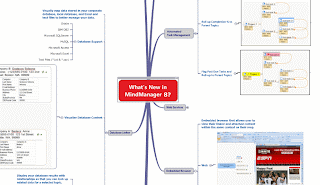 It has been hard to contain myself over the last month, since I had a chance to beta test the latest version of MindManager 8 which will be released today. Built on the strong foundation of MindManager 7, version 8 breaks new ground with some really exciting features. MindManager 8 breaks new ground with the introduction of the Mindjet Player which now allows you to share and publish your maps with just about anyone. It is now easy with MindManager 8 to transforms your maps into fully interactive Adobe PDFs or Flash .SWF files. They can be shared with anyone, published to blogs and embedded in web pages. When you see this feature you too will be amazed how you can interact with your maps with nothing else but the Adobe Acrobat Reader installed on your computer. This is really going to change the way we publish and share our maps without the worry if the person on the other end has a copy of MindManager 8 installed on their computer. I can go on for days talking about this feature and look for a screencast about this in the coming days. In the same vein, Mindjet will be releasing a new version of MindManager Web which will allow you to access and collaborate on the web with your mind maps in a secure web workspace. Similar to Google Docs, you will now be able within any browser to open and co-edit your maps with other as you collaborate with clients on your projects. Using the same conventions to insert topics and format your maps you will be up and running using MindManager Web in no time and if you would like you can also access your maps with the desktop version of MindManager 8. Having both Mindjet Player and MindManager Web ensure that you and your clients can have access to your maps wherever you are.
It has been hard to contain myself over the last month, since I had a chance to beta test the latest version of MindManager 8 which will be released today. Built on the strong foundation of MindManager 7, version 8 breaks new ground with some really exciting features. MindManager 8 breaks new ground with the introduction of the Mindjet Player which now allows you to share and publish your maps with just about anyone. It is now easy with MindManager 8 to transforms your maps into fully interactive Adobe PDFs or Flash .SWF files. They can be shared with anyone, published to blogs and embedded in web pages. When you see this feature you too will be amazed how you can interact with your maps with nothing else but the Adobe Acrobat Reader installed on your computer. This is really going to change the way we publish and share our maps without the worry if the person on the other end has a copy of MindManager 8 installed on their computer. I can go on for days talking about this feature and look for a screencast about this in the coming days. In the same vein, Mindjet will be releasing a new version of MindManager Web which will allow you to access and collaborate on the web with your mind maps in a secure web workspace. Similar to Google Docs, you will now be able within any browser to open and co-edit your maps with other as you collaborate with clients on your projects. Using the same conventions to insert topics and format your maps you will be up and running using MindManager Web in no time and if you would like you can also access your maps with the desktop version of MindManager 8. Having both Mindjet Player and MindManager Web ensure that you and your clients can have access to your maps wherever you are. One of the key design decisions that was made at Mindjet is clear once you start using MindManager 8; that is that you can work within MindManager 8 without having to leave the environment to view URL’s or for that matter viewing or editing Microsoft Office documents. That’s right now when you click on a URL it opens a Browser window right within MindManager 8- pretty cool. I’m sure you will agree-but it gets even better in that now when you click on a Microsoft Office document (Word, Excel, Project, PowerPoint) it opens in a window within MindManager 8 and can be viewed and edited. No need to have Word or Excel open- just edit and view within MindManager 8. For those of you have been using MindManager for awhile- I had always enjoyed using the Google search API which allowed me to do live searches within MindManager. Somehow along the way of new versions the API no longer worked- but now you can do live Google and Yahoo! searches can be directly inside a map, with mapped and editable search results that can be refreshed with one click, or automatically updated each time you open your map. MindManager 8 can also search Amazon, Facebook, MySpace, Microsoft Live Search, eBay, and StrikeIron. I’m confident that with this new ability that other 3rd party developers will build new search parts that we can use with MindManager 8. MindManager has become an extremely important tool for project planning and in the latest version Mindjet has answered our call and really beefed up its task management capabilities. MindManager 8 now includes automated task management that provides instant summations of task start date, end dates, level of completion, and exception management. It is now easier than ever to set dependencies and watch how MindManager 8 is able to instantly calculate the dates when tasks are due- if a task falls behind schedule MindManager 8 will color code the task to visually show you where you need to focus. And last but not least, MindManager 8 can now incorporate real time information from spreadsheets and databases with the new Database Linker feature. MindManager 8 can now access data from MS Excel, Oracle, IBM DB2, MS SQL Server, MS Access, and MySQL. I’m sure you will agree that this is a very substantial upgrade and one that I’m really very excited about. To find out more information about MindManager 8 please click on the link.

